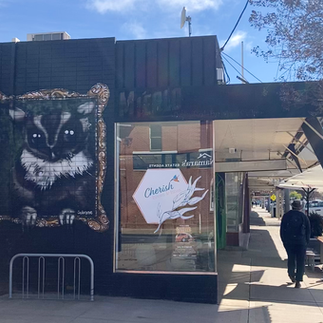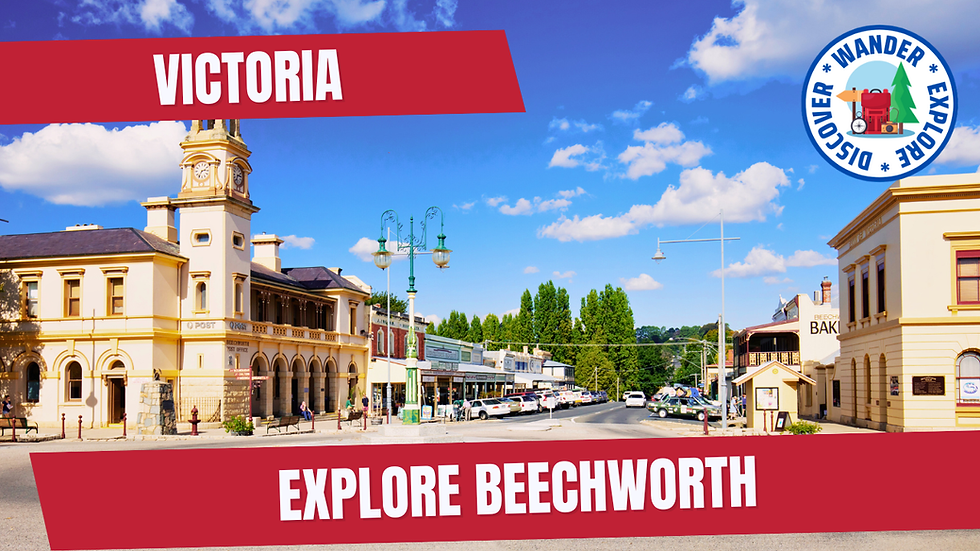Explore Numurkah
- Wander * Explore * Discover

- Sep 6
- 3 min read
Updated: 6 days ago
Numurkah ~ Victoria
Numurkah is a small country town on Broken Creek. It is located on the Goulburn Valley Highway, 227 kilometres north of Melbourne and 37 kilometres from Shepparton. It has lovely parks and gardens, heritage buildings, and great cafes.
When we stayed in Numurkah, we enjoyed morning tea at a lovely cafe, saw street art and interesting heritage buildings. We explored Rotary Park, Broken Creek and visited the Kinnairds Wetlands. We also went for a drive to Cactus Country and saw some amazing silo art.
Numurkah Town Centre & Cafe
Mellville Street is Numurkah’s town centre, and it has a great selection of cafes, traditional hotels, supermarkets, restaurants and specialty shops to browse in.
Cherish Brews and Bites is a great cafe that is open daily from 6.00 am to 2.00 pm and is next to a lovely colourful street mural.
The 20-metre-long mural was painted by well-known artist Sobrane and features local birds, including a superb blue wren, an azure kingfisher, and a budgie.
We admired the mural while enjoying coffee and muffins from the cafe.
Numurkah Heritage Buildings
The Numurkah township was proclaimed in 1875, and there are many interesting heritage buildings with information plaques along the main street.
Number 70 Melville Street was originally a chemist's, built in 1881; it was the first brick building in town, and it is now a real estate office.
The Courthouse was built in 1890 and now houses an arts and crafts centre.
The Bank of Victoria was built in 1892 and now houses the Numurkah Historical Society.
The Numurkah Leader Newspaper building was built in 1896. A fire destroyed the building in the 1980’s but luckily the facade remained intact.
The Numurkah Hotel was built in 1911 and is still used as a hotel today.
The State Savings Bank was built in 1912 and is now a real estate office.
The Telegraph Hotel is a lovely two-storey Victorian-style building that was built in 1923.
In the centre of Mellville Street is a miniature replica of the Dethridge water wheel, an Australian invention from 1910 used to measure water flow for irrigation.
There is also a lovely mural on the Numurkah Kindergarten building.
Broken Creek & Rotary Park
We wandered along the Broken Creek walking track past Apex Park, which has a children's playground, toilets and picnic tables.
We then reached Rotary Park, where an old steam train and a collection of brightly painted tractors are located. We also saw the Frank Yarwood Pavilion, which has an interesting collection of old machinery and memorabilia with informative signs.
On the other side of Broken Creek, you can see a small colony of grey-headed flying foxes and little red flying foxes. During the day, they can be seen roosting in the large river red gum trees along the creek. In the evening, after the sun has set, you can watch them fly off into the night.
Kinnairds Wetlands
Kinnairds Wetlands is located 2 kilometres from Numurkah and is a natural and man-made wetland. There are several walking tracks around the wetlands, and we enjoyed a nice bushwalk.
Cactus Country
Cactus Country is Australia’s largest cactus garden, and they are located in Strathmerton, approximately 20 kilometres from Numurkah. They are open Wednesday to Sunday from 10.00 am to 5.00 pm.
The gardens cover 12 acres and feature thousands of cacti and succulents from places like Mexico, the Sahara, Patagonia, and South Africa.
There are eight different colour-coded trails to wander around and admire the cactus, and lots of fun photo opportunities.
After wandering around, we enjoyed nachos and frozen margaritas in the Mexican-themed cafe, and you can also sit outside in the colourful courtyard.
There is a lovely selection of gifts and an on-site cactus nursery where you can take home your own little cactus as a memento.
Katamatite Silo
The Katamatite Silos were painted by Tim Bowtell in July 2023.
The mural weaves together local heritage, Indigenous culture, and community history, featuring a wedge-tailed eagle, Indigenous figures along Boosey Creek, a scar tree, the town’s first train engine, and imagery of irrigation that shaped the farming region.
It connects past and present, paying tribute to both traditional owners and early settlers.
_edited.png)



















































Comments